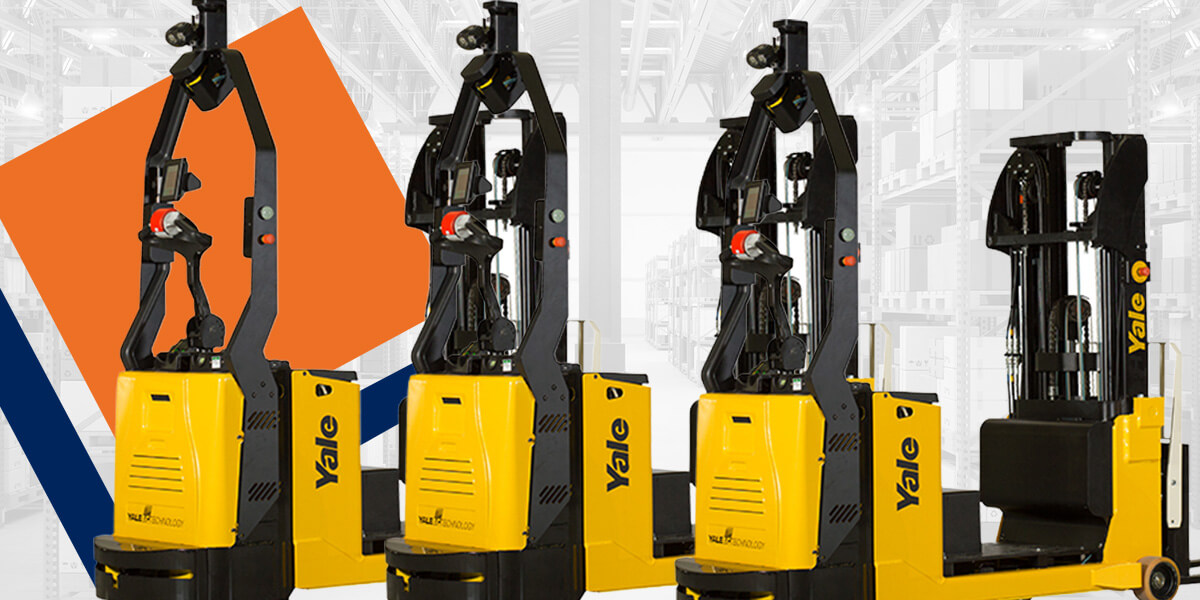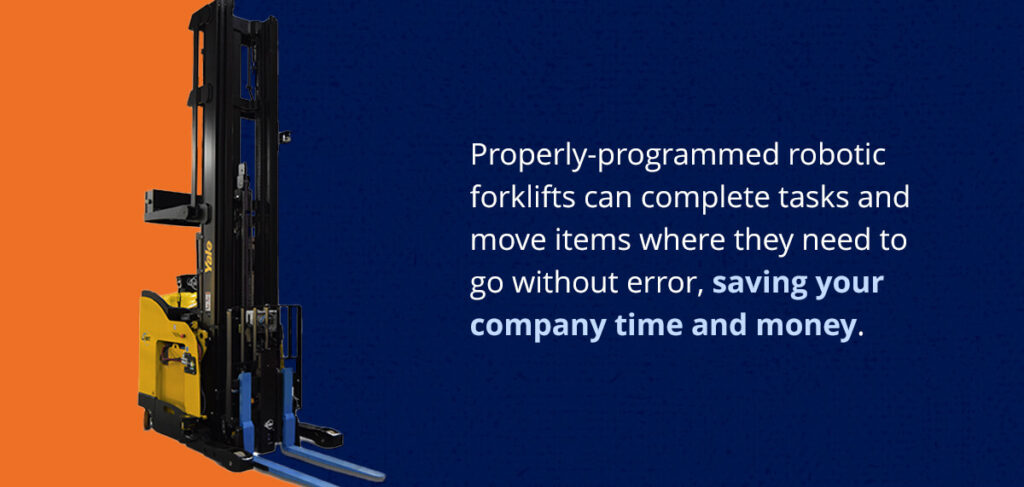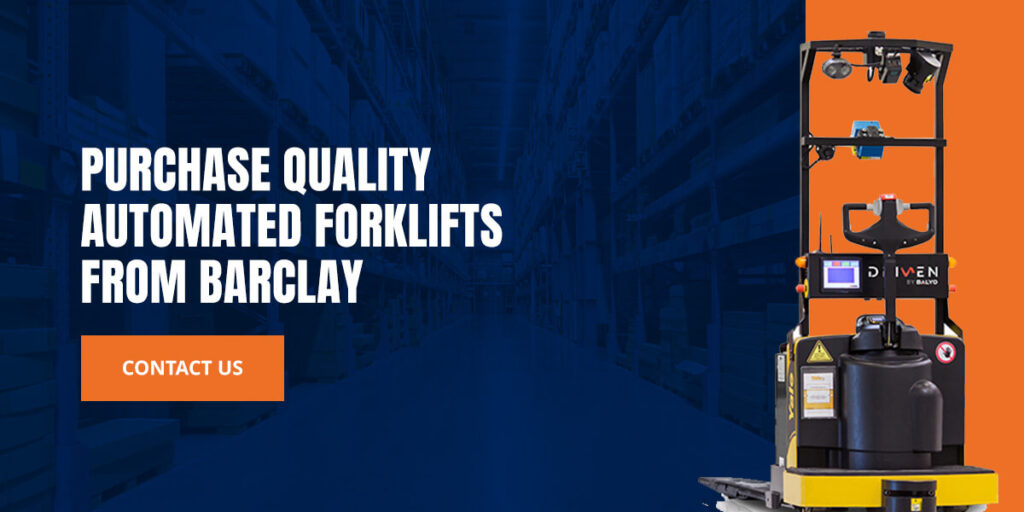
Robotic forklifts use innovative technology to automate operations, increasing productivity and decreasing costs. Implementing automated forklift technology in your facility enables employees to focus on more valuable jobs while a machine takes care of the repetitive tasks.
Understanding robotic forklift capabilities and benefits can help you determine if this automated technology is right for your warehouse or distribution center.
What Are Robotic Forklifts?
Robotic forklifts are automated guided vehicles (AGVs). These technologically-advanced machines can complete tasks and perform workflows with minimal human interference, allowing people to avoid unpleasant or repetitive tasks. AGV forklifts are self-driving vehicles that can operate devices, communicate with other equipment, plan warehouse routes and move items.
How Do Robotic Forklifts Work?
In the 1950s, AGV forklifts self-navigated using radio waves, lasers or floor markings. Today’s innovative technology enables an automated forklift to move independently without lasers, floor lines or radio waves.
Warehouse robotics use special programming to perform the following actions:
- Track and monitor human workers
- Sense their surroundings to avoid obstacles
- Detect and predict human worker movements to work around them safely
- Mimic human worker actions
- Lift and move items around a warehouse
- Stack items on warehouse shelves
- Communicate with other technologically advanced machines and equipment
- Operate technology such as roller tracks and doors
- Learn actions to take and where to move
- Avoid obstacles
- Plan the safest and quickest routes around a warehouse
Advanced computer technology enables humans to program automated forklifts to perform specific tasks. This technology also gathers data, allowing the forklifts to continuously improve their performance.
What Are The Types of Robotic Forklifts?
Various robotic forklift types have different load capacities and can lift pallets to different heights. If you’re looking for an automated lift truck for your facility, consider the following options:
1. Reach Trucks
Yale Robotic Reach Trucks retrieve and lift loads to optimize vertical storage space. They can reach over 30 feet high and transport up to 3,500 pounds at a time. An automated reach truck is ideal for warehouses and distribution centers experiencing significant inventory growth because it can handle double-deep pallet storage, complete small tasks and expand its operation when necessary.
2. End Riders
End riders perform horizontal pallet transfers. A Yale Robotic End Rider can lift up to 8,000 pounds and move pallets down long paths. This automated machine allows your workers to focus on the tasks they find valuable while it completes the repetitive duty of moving pallets. Similar to a reach truck, the Robotic End Rider can complete small duties and expand when inventory increases.
3. Counterbalanced Stackers
A Yale Robotic Counterbalanced Stacker meets vertical and horizontal pallet transport needs. Counterbalanced Stackers can handle 1,900 to 2,600-pound loads and reach up to 67 inches, allowing them to retrieve pallets from and deliver pallets to vertical and horizontal storage spaces. This type of automated forklift can move products between conveyor lines and storage spaces safely and efficiently, and it can complete small jobs or expand to meet greater needs.
4. Tow Tractors
Robotic Tow Tractors tow large loads, allowing employees to avoid repetitive tasks for more engaging ones. A Yale Robotic Tow Tractor can handle up to 15,000 pounds, making it an excellent solution for tasks such as garbage hauls and parts sequencing. It can work for small and large jobs and is ideal for busy warehouses.
Pros and Cons of Robotic Forklifts
Robotic forklifts offer significant benefits with minimal drawbacks, and the pros far outweigh the cons. While robotic forklifts may cost more than traditional manual forklifts, they’re the future of warehouse operations and provide the following benefits:
1. Less Damage
Investing in automated forklifts can minimize damage around a warehouse. Because a robotic forklift contains the technology to sense its surroundings in detail, it can detect and avoid obstacles.
Moving around other machines, warehouse structures and various equipment safely prevents collisions. Human error is always possible when humans manually operate forklifts, but automatic forklifts remove the need for human operation.
2. Enhanced Safety
A robotic forklift’s ability to sense its surroundings also enhances human safety. Adding automated forklifts to your workforce can decrease collisions, tip-overs and injuries such as back or neck strains.
Avoiding accidents in manual forklifts requires human operators to remain alert and focused, but a person’s ability to focus can fluctuate throughout the day, especially when distractions arise.
Automated forklifts maintain consistent detection, allowing them to move around humans safely and prevent workplace accidents. They also secure items properly and transport loads within appropriate weight limits at all times.
Automated forklifts can perform hazardous tasks for humans, protecting workers from potential harm and preventing injuries. You can use a robotic forklift to operate in harsh conditions and handle hazardous materials, allowing your employees to avoid risks.
3. Increased Productivity
Automated forklifts can increase warehouse productivity. Their ability to operate consistently and plan the most efficient routes allows them to complete tasks faster than a human-operated forklift. A robotic forklift can work without taking breaks, and it delivers consistent performance.

Automated forklifts also decrease task errors. Properly-programmed robotic forklifts can complete tasks and move items where they need to go without error, saving your company time and money.
4. Cost Savings
With automated forklifts in your warehouse, you can reduce your workforce and its related costs. A warehouse with self-driving forklifts requires fewer operators, allowing you to save money on the following factors:
- Payroll
- Payroll taxes
- Workman’s compensation insurance
- Employee injury or illness downtime
- Employee benefits
- Overtime pay
While using robotic forklifts enables you to hire a smaller workforce, it doesn’t mean you must eliminate your valued employees. Implementing advanced forklift automation can help you reallocate each employee’s skills and abilities to other important areas.
Employees who once operated manual forklifts can oversee and maintain automated forklifts. They can also shift their focus to other duties such as non-repetitive tasks, inventory monitoring or product packaging.
5. Efficient Maintenance
An automated forklift’s technological features enable it to send real-time data to mobile devices. With data analytics and feedback, warehouse managers can keep track of forklift conditions, schedule regular maintenance and request repairs efficiently. Maintaining forklifts with predictive maintenance can reduce machine downtime and prevent expensive repairs.
Are Automated Forklifts Worth the Cost?
Automated forklifts require time and money upfront, but they can deliver an excellent return on investment. Robotic forklift implementation requires an upfront purchase, regular maintenance fees and time training employees how to work with and around the automated forklift.
You can gradually recover these costs with the significant savings forklift automation provides. This technology can save you money on wages, insurance, benefits and costly repairs. It can also increase your profits as it enhances your company’s productivity.

Purchase Quality Automated Forklifts From Barclay
Robotic forklifts are the future of warehouse and distribution center operations. An automated lift truck can significantly increase your facility’s productivity, safety and return on investment. Barclay offers high-quality automated forklifts to help companies boost their business with cutting-edge technology.
Contact Barclay to learn more about our wide selection of robotic forklifts.







